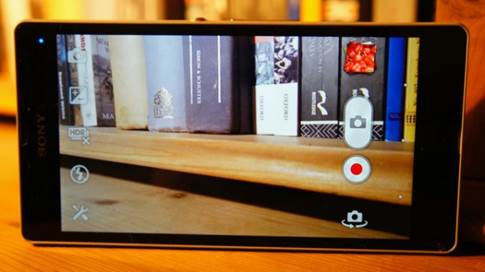While quite many companies have released
phones with 5-inch screens, 1080p, Xperia Z still is one of the first phones
reviewed, if not wanting to say ‘the first’. The phone has a higher resolution
than Xperia T’s, and because its size has only slightly increased (4.6 inches
to 5 inches), it offers a higher screen density of 433pixels per inch. As we
mentioned in our Droid DNA review, but increasing from 720p to 1080p is not a
big leap compared to from qHD to 720p, we are not saying that you will not take
notice of the sharper fonts, more vivid images and fresher imaging overview.

Sony
new Xperia Z’s screen with the power button on its edge
To compare Xperia Z with the only other
1080p phone that we have assessed, the Droid DNA, Sony unfortunately came in
second place. Sony calls its new screen, thinner screen the OptiContrast, but
its performance does not provide a viewing angle or outdoor performance is
equivalent to HTC's Super LCD 3 screen. In fact, when you turn the screen out of
the direct viewing angle, you will see the washy discoloring that starts to
penetrate into what is going on - especially in bright light. Although, Sony
says the new screen structure can reduce glare, sunlight and certain lighting conditions
often make it difficult for us to see the home screen.
As we have seen on Sony’s previous mobile
screens, the black background and details often seem more like dark gray. The
phone is often too bright - setting the brightness of the Xperia Z can be
related to a wider range of brightness and a lower base setting. We do not want
to ignore the brightest option, as while you will not fear the rain with a
waterproof Z model, we need one of the highest brightness settings to see what
we are doing on the touch screen when the sun emerges.
This is the first phone with Sony's
improved Mobile Bravia Engine 2 technology, which takes charge much of the
sharpness and contrast increases to photos and videos (even if they are
recorded on your phone or downloaded from other sources). Software will vary
the darker areas to blacker ones, while distortion from the low quality of
YouTube videos is also less reduced, for example - the video looks a bit
smoother. On the contrary, there is a sharpness filter for the images, which enhances
the edges and contrast and that it does not seem to increase the noise. The
supplements seem to be eager than Sony’s previous phones, and when we looked at
the recent photos, we found excessive green color on some images, regardless of
white balance options. It seems not to be associated with Bravia tweaks (which
can be turned off if you do not like over-saturated images) and seems to be
significantly reduced when we watch them on other devices, such as the PC.
Camera
It was the first launch of Sony's new Exmor
RS sensor. A promise of improved signal processing, it is a completely new
sensor with the same image size of the Xperia T (12-megapixels). The remarkable
improvement here is the HDR video, which provides the greater dynamic range of
lighting in your video. In fact, it works well. We tested a great deal of
cameras, and the new features of the Xperia Z in general provide the better
lighting layout during our tests. Sometimes, it processes colors excessively,
with much more noise, but of course, we will accept that in exchange for a
better light balance. Please see our sample video, recorded in a dim
underground tunnel.

The
new features of the Xperia Z in general provide the better lighting layout
during our tests.
Naturally, you can also capture the HDR
images, although the duration of checking the camera, we found that the new
"auto i+" setting generally provided the better results than what we
got with HDR options or manual setting tweaks. The new auto settings mainly do
a good job of adjusting ISO, white balance and changing HDR. After we had taken
the comparison photos, we left the phone in the auto mode to take most
pictures.
Most of the photos were taken on the
9-megapixel setting available and although the phone outputs the photos at
12-megapixels with the ratio of 4:3, which cannot be fully capable of
high-resolution screen.
However, when comparing the two sizes with
8-megapixel images of the rivals, we found that these bigger images give a
little more details. The 9-megapixel image looks almost similar to the
12-megapixel image sample in quality, even though the subject seems to be
closer. The good color reproduction, with HDR brings enhancements to our
low-light images. We noted that HDR mode for images was quite subtle - certainly
it is due to the changes of Exmor S sensor that we have heard about late last
year. Compared with the images in the normal mode, the dark areas seem a little
brighter. So, it is bad news if you are expecting the similar fictitious
effects that you get on the other HDR cameras, but at least it's more
realistic.

A
picture taken by Sony Xperia Z
Sony has also had to adjust to the camera
interface, which at least had a good start, with access to ISO and white
balance, not counting the ability to create shortcuts for them on the camera
interface. There is now a burst mode that can capture with the10fps speed at
9-megapixel resolution. At this time, you can take pictures while recording
video, but it's better, you do not need to switch between camera and video
camera modes simply select the appropriate record button. If you have used one
of the point-and-shoot cameras from Sony (or even NEX cameras), you will
recognize that the navigation and the icons were transported across. As the
button details from Vita, it's great to see that the multiple electronics
series of Sony have ultimately begun to converge with each other.